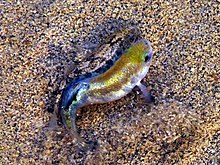Death Valley pupfish
| Death Valley Pupfish | |
|---|---|

| |
| Male (right) and female (left) | |
| Scientific classification | |
| Domain: | Eukaryota |
| Kingdom: | Animalia |
| Phylum: | Chordata |
| Class: | Actinopterygii |
| Order: | Cyprinodontiformes |
| Family: | Cyprinodontidae |
| Genus: | Cyprinodon |
| Species: | C. salinus
|
| Binomial name | |
| Cyprinodon salinus R. R. Miller, 1943
| |
| Subspecies | |
| |
The Death Valley pupfish (Cyprinodon salinus), also known as Salt Creek pupfish, is found in Death Valley National Park. There are two recognized subspecies: C. s. salinus and C. s. milleri. It is endemic to two small, isolated locations and currently classified as endangered.
Description

The desert pupfish is a small, silvery colored fish with 6-9 dark bands on its sides. It has an average length of 3.7 centimetres (1.5 in), with a recorded maximum of 7.8 centimetres (3.1 in).[2]
The males turn bright blue during mating season, April through October. The pupfish can withstand harsh conditions that would kill other fish: water that is 4 times more saline than the ocean, hot water up to 116 °F (47 °C), and cold water down to 32 °F (0 °C).[3]
Distribution and habitat
This species is known from only two locations in Death Valley: Salt Creek (subspecies salinus) at about 49 meters below sea level, and Cottonball Marsh (subspecies milleri), at about 80 meters below sea level.[1] They are thought to be the remainders of a large ecosystem of fish species that lived in Lake Manly, which dried up at the end of the last ice age leaving the present day Death Valley.[4]
The Salt Creek subspecies is also found at River Springs and Soda Lake, in Death Valley National Park.[3]
Conservation
The desert pupfish has been classified as endangered by the IUCN due to its extremely restricted distribution (if the two extant locations were treated as a single unit, it would be considered critically endangered). Numbers of individuals at the locations are highly seasonally variable, and fluctuate with water level and flow volume. While the entire range of the species is located in a protected area, it may be under threat from accidental introduction of non-native species, local catastrophic events, and excessive pumping of the aquifer that feeds the habitat.[1]
See also
- Pupfish
- Cyprinodon - Genus
Other local Cyprinodons
- Tecopa Pupfish, Cyprinodon nevadensis calidae (extinct)
- Saratoga pupfish, Cyprinodon nevadensis nevadensis (subspecies)
Found at Saratoga Springs at the south end of Death Valley. - Amargosa pupfish, Cyprinodon nevadensis amargosae
Found in the Amargosa River northwest of Saratoga Springs. - Devil's Hole pupfish, Cyprinodon diabolis, critically endangered.
Found in Devil's Hole 37 miles (60 km) east of Furnace Creek, in western Nevada. - Shoshone Pupfish, Cyprinodon nevadensis shoshone
- Desert pupfish Cyprinodon macularius
- Owens pupfish Cyprinodon radiosus
References
- ^ a b c NatureServe (2013). "Cyprinodon salinus". The IUCN Red List of Threatened Species. 2013: e.T62211A15362833. doi:10.2305/IUCN.UK.2013-1.RLTS.T62211A15362833.en. Retrieved 10 November 2017.
- ^ Froese, Rainer; Pauly, Daniel (eds.). "Cyprinodon salinus". FishBase. December 2015 version.
- ^ a b "Salt Creek pupfish". U.S. Bureau of Land Management. Retrieved 2016-05-15.
- ^ US Geological Survey (30 June 2000). "Shoreline Butte: Ice age Death Valley". Death Valley Geology Field Trip Shoreline Butte. Department of the Interior. Retrieved 2009-09-10.
Further reading
- Duvernell, D. D.; Turner, B. J. (1999). "Variation and divergence of Death Valley pupfish populations at retrotransposon-defined loci" (PDF). Molecular Biology and Evolution. 16 (3): 363–371. doi:10.1093/oxfordjournals.molbev.a026117.
- Lema, S. C. (2008). "The phenotypic plasticity of Death Valley's pupfish: desert fish are revealing how the environment alters development to modify body shape and behavior". American Scientist. 96 (1): 28. doi:10.1511/2008.69.3668.
- Jahren, A. H.; Sanford, K. L. (2002). "Ground-water is the ultimate source of the Salt Creek pupfish habitat, Death Valley, U.S.A" (PDF). Journal of Arid Environments. 51 (3): 401–411. Bibcode:2002JArEn..51..401J. doi:10.1006/jare.2001.0950.
External links
 Media related to Cyprinodon salinus at Wikimedia Commons
Media related to Cyprinodon salinus at Wikimedia Commons- "Cyprinodon salinus". Integrated Taxonomic Information System. Retrieved 18 January 2014.

